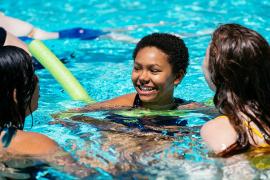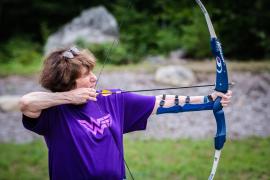The path to recognizing neurodiversity — “the notion that conditions like autism, dyslexia, and attention-deficit/hyperactivity disorder (ADHD) should be regarded as naturally occurring cognitive variations with distinctive strengths that have contributed to the evolution of technology and culture rather than mere checklists of deficits and dysfunctions” (Silberman, 2015) — has been a long and winding one. Camping Magazine recently spoke with Steve Silberman, New York Times best-selling author of NeuroTribes: The Legacy of Autism and the Future of Neurodiversity, to discuss old attitudes, the changing definition of autism, and the beginning of a social movement aimed at ensuring that neurodivergent people have a seat at society’s the proverbial table.
First off, tell us a little bit about yourself and your background.
I grew up in New York City. I went to a Jewish day camp when I was a little kid. I eventually got interested in writing and poetry, and I became Allen Ginsburg’s [famous American Beat Generation writer] teaching assistant in college. I was a senior science writer for Wired magazine for about 15 years.
How did you become interested in the subject of autism?
In 2000, I was on a boat in Alaska with more than 100 computer programmers for a “geek cruise.” As one might imagine, there were a lot of socially awkward but also very brilliant people who had worked on the foundations of the web. The star of the cruise, Larry Wall, had invented the computer programming language Perl, which made a lot of the early web possible. Larry was a really weird and eccentric and brilliant guy. I wanted to do a follow-up interview at his home in Silicon Valley, and he said, “Sure, but I should tell you that I have a profoundly autistic daughter.”
A few months later, I was writing about a highly regarded female technologist also in Silicon Valley. I reached out to her brother-in-law and asked if I could interview him at home. He said, “Sure, but just so you know, we have an autistic daughter.”
It certainly seemed like a coincidence that two technically accomplished families in Silicon Valley had children with a rare neurological disorder, and the next day I was telling a friend about it at a café, and a young woman at the next table blurted out, “I’m a special-education teacher. Do you realize there is an epidemic of autism in Silicon Valley? Something terrible is happening to our children.”
I started reading everything I could find on autism.
Then I did a story in 2001 called “The Geek Syndrome” about autism in high-tech communities, the first of its kind in the mainstream press. I got emails about it for 10 years after that. They were about people who were unable to access very basic services because of the lack of societal supports. It was hard for them to get healthcare, jobs — there were people who didn’t understand their relatives until they read the article. And during that 10-year period, the number of autism patients kept going up, and why was a mystery. I began to feel that something had gone wrong in the timeline of autism’s history and thought if we understood the real timeline of history better, we might understand the rise.
What did you learn through your research?
There had been some major errors in the autism timeline. The diagnosis of autism was said to have been invented by Leo Kanner in the 1940s. He had noticed that 11 of his young patients seemed to inhabit private worlds, ignoring the people around them. Kanner named the condition autism, from the Greek word for self (autos), because they seemed happiest in isolation. However, research was going on in the 1930s in Hans Asperger’s clinic in Vienna, Austria. No one heard of Asperger because of his clinic’s ties to Nazi Germany. His research was discredited by the association, though two of his closest colleagues were Jewish.
Asperger and his colleagues had developed a model, an autism continuum, a broad range of abilities and struggles — everywhere from people who couldn’t speak to those who spoke through keyboards, or who were brilliant but may have had social difficulties.
Kanner always said that autism was rare. He estimated that he had seen only 150 cases in his lifetime at one point.
Asperger said once you learn to recognize the distinctive traits of autism, you see them everywhere.
Asperger got that right, and Kanner got that wrong.
Asperger and his colleagues believed if you support the unique interests of the autistic, that can become a pathway to success in society and a happy life.
Kanner’s model recommended suppressing those interests.
In truth, Leo Kanner and his wife heroically saved Jews during the war, and he saved Asperger’s former assistants, who fled Nazi persecution. The two autism discoveries were intimately linked, but Kanner’s autism conception dominated the field for more than 40 years. To him, autism was a tragic form of childhood psychosis, akin to schizophrenia, caused by inadequate parenting.
Lorna Wing, a psychiatrist in England with an autistic daughter, was asked by the National Health Service to look into whether families of cognitively disabled children were being provided with adequate resources. Her husband had translated Asperger’s research paper from the ’40s, and when Lorna saw it, she said, “We have to change the diagnosis.” She and her colleagues worked really hard to widen the gates of autism diagnosis. She introduced the term Asperger syndrome.
We went from an artificially narrow number of diagnoses to a more realistic view.
INTERVIEWER’S NOTE: Only a portion of Silberman’s answer is presented here. For a more complete picture of the history and evolution of autism, refer to his book, NeuroTribes: The Legacy of Autism and the Future of Neurodiversity.
You quoted Kristina Chew, a woman with an autistic son, as saying, “I had an image of what Charlie ‘should’ be. I wasn’t keeping my eyes focused on the real boy in front of me. I realized that the ‘autism wars’ were inside of me.” She’s talking about bias. In your mind, what’s the status of the autism wars today?
The disastrous prediction of the lives of autistic children that was given to parents in the past was based on kids who were subjected to harsh and brutal treatments and had bleak outcomes. That just isn’t true today. Kids exceeding the dire predictions of their pediatricians has been going on long enough that parents are realizing their kids are amazing.
Autistic children have a path through life with a lot of support, and society has really woken up to the fact that they have a tremendous amount of potential with originality and creativity of thought, which can be a huge advantage. Autistic people have been overlooked, mocked, but given the right kind of support, they can be leaders in their fields.
One of the things I realized was that a lot of the creativity that came out of Silicon Valley was generated by people who had autistic traits. They have contributed to the advancement of science, art, and culture.
The term “neurodiversity” hasn’t been around all that long. Where did it come from?
Judy Singer, a graduate student in anthropology and sociology in Australia coined the term “neurodiversity” in the late ’90s. Her mother was autistic. And she realized that she herself had a lot of autistic traits, as did her daughter, but she didn’t meet Kanner’s criteria.
What Judy realized was that people like her family only had negative words to describe their condition — they were impaired in some way. She coined the term to express that diversity in human minds is good for society.
One of Judy’s mentors was a guy who had survived polio and subscribed to the social model of disability — it’s not only located in the person but also in the way society fails to provide the support the individual needs. For example, if you live in a town that has wheelchair ramps, for someone in a wheelchair that’s a good thing. They’re going to be more successful than someone who is in a wheelchair and living in a town that doesn’t have those.
Neurodiversity took the social model of physical disabilities and applied it to cognitive disabilities. Judy hoped that the term would become a rallying cry like “Black is beautiful,” “Gay is good,” and “Sisterhood is powerful.” It has worked. The word neurodiversity has become a global movement for “odd people out.”
You said that “just because a computer is not running Windows doesn’t mean it’s broken,” a great analogy in my opinion. What does it mean to think about neurodiversity in terms of the brain being a human operating system?
For a long time, humanity has had a mistaken notion that there’s only one type of normal brain. If it doesn’t work that one way, it’s inferior or damaged. The neurodiversity perspective points out that a diversity of the way brains (human operating systems) work is good. We need to take care of the people whose brains work in ways that are not considered normal. It’s about including more of the ways that people can be fantastic. Just like in the world of computing there are different types of operating systems for different tasks, there are different brains for different jobs.
Temple Grandin, probably the most famous autistic person, said if she wasn’t autistic, she wouldn’t have been able to come up with the ideas she’s had in designing plans for livestock facilities.
When people say my daughter is not like Temple Grandin — well, Temple Grandin was not like Temple Grandin when she was five. She grew into a very influential, creative mind when she got support. She was a pioneer of what can happen when an autistic brain is nurtured rather than punished for being weird.
What has the neurodiversity movement done for individuals on the spectrum?
For decades, almost no autism research was devoted to improving the lives of the autistic; rather the research was all about trying to prevent autism from happening. Nobody knows what causes autism. The United States invested billions of dollars in identifying autism risk factors, but what about the fact that unemployment is a huge factor in the autistic community? What we need to do if figure out how to make the lives of autistic people happier, better, and more engaged.
The movement and autistic self-advocates have successfully changed the direction of science toward areas that will improve the lives of the autistic now. For example, we now know that autistic people experience trauma differently; they are more affected. What’s that about? How about focusing on that?
Autistic people are starting to determine the direction of autism research and representation. They should feel proud of who they are — because they’re beautiful.
I loved the example in your book of Broadway productions that offer “autism-friendly” performances of hit shows like Mary Poppins and The Lion King by limiting use of strobe lights and pyrotechnics on stage and providing quiet areas in the lobby. Are there steps like those taken for those performances that summer camps could employ to make the experience more accommodating for neurodiverse campers?
The first thing to do is talk to the campers themselves and find out what they’re comfortable with and what they want.
Be aware that the sensory environment can be pretty challenging. Provide alternate environments for those more comfortable with less sensory bombardment. It can allow people with neurodivergent conditions to participate.
Peer mentoring is also really important. Consider bringing in an autistic adult to talk about what has worked for them. Nothing is more inspiring to a young person that an adult who is succeeding under similar circumstances.
It’s good to be aware that neurodivergent people are often going to feel excluded and be bullied. That creates trauma, which can have lifelong effects. So it’s really important that we develop models of tolerance and inclusion to help us broaden our views of what a successful and creative life looks like.
Based on what you learned through all your research and interactions with some pretty amazing neurodiverse individuals and their families, is there any other advice you’d give camp professionals whose aim is to provide all children with positive social-emotional learning experiences at camp?
Give every individual what they need to have the best chance of success, which includes respect, tolerance of differences, and celebrating eccentricity rather than punishing it.
This interview was conducted by Marcia Ellett, Camping Magazine’s editor in chief.
Reference
Silberman, S. (2015). NeuroTribes: The legacy of autism and the future of neurodiversity. New York, NY: Avery.




